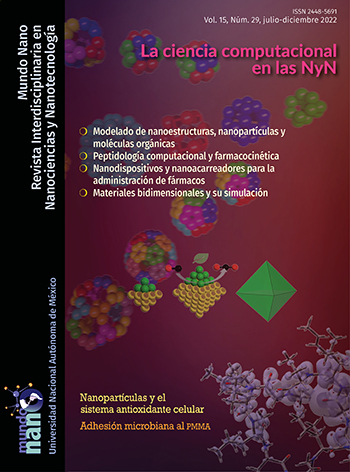Oligomeric approach to 2D materials modeling
Contenido principal del artículo
Resumen
Oligomeric approach has been originally developed to study electronic properties of conjugated polymers. This approach allows to access electronic properties of 1D systems otherwise difficult to calculate. We successfully extended this method to study electronic properties of 2D materials. In this review we summarize our recent work in this area. It has been established that large graphene nanoflake possess multiconfigurational singlet or even high spin ground state. Doping of 2D systems has also been explored and it has been demonstrated that doping allows to tune their electronic properties, including ionization potentials, electron affinities, reorganization energies and the very nature of the ground state. The electronic properties of novel 2D allotropies of carbon, phosphorus, germanium and silicon have been studied as well as their complexes with Li. Heterostructures, of different 2D allotropies are readily formed. This is an alternative method for tuning of their electronic properties.
Descargas
Detalles del artículo

Mundo Nano. Revista Interdisciplinaria en Nanociencias y Nanotecnología, editada por la Universidad Nacional Autónoma de México, se distribuye bajo una Licencia Creative Commons Atribución-NoComercial 4.0 Internacional.
Basada en una obra en http://www.mundonano.unam.mx.
Citas
Becke, A. D. (1993). Density‐functional thermochemistry. III. The role of exact exchange. The Journal of Chemical Physics, 98(7). https://doi.org/10.1063/1.464913 DOI: https://doi.org/10.1063/1.464913
Chuvilin, A., Meyer, J. C., Algara-Siller, G., Kaiser, U. (2009). From graphene constrictions to single carbon chains. New Journal of Physics, 11(8): 083019. https://doi.org/10.1088/1367-2630/11/8/083019 DOI: https://doi.org/10.1088/1367-2630/11/8/083019
De la Garza, C. G. V., García, G. L., Olmedo, E. M., Peña, E. R., Fomine, S. (2018). Electronic structure of isomeric graphene nanoflakes. Computational and Theoretical Chemistry, 1140: 125–133. https://doi.org/10.1016/j.comptc.2018.08.007 DOI: https://doi.org/10.1016/j.comptc.2018.08.007
De la Garza, C. G.V., Olmedo, E. M., Fomine, S. (2019). Electronic structure of boron and nitrogen doped isomeric graphene nanoflakes. Computational and Theoretical Chemistry, 1151: 12-23. https://doi.org/10.1016/j.comptc.2019.01.022 DOI: https://doi.org/10.1016/j.comptc.2019.01.022
De la Garza, C. G. V., Narváez, W. E. V., Rodríguez, L. D. S., Fomine, S. (2020). Electronic structure of hybrid pentaheptite carbon nanoflakes containing boron-nitrogen motifs. Journal of Molecular Modeling, 26(4): 72. https://doi.org/10.1007/s00894-020-4324-9 DOI: https://doi.org/10.1007/s00894-020-4324-9
De la Garza, C. G. V., Narváez, W. E. V., Rodríguez, L. D. S., Fomine, S. (2021). Novel 2D allotropic forms and nanoflakes of silicon, phosphorus, and germanium: a computational study. Journal of Molecular Modeling, 27(5): 142. https://doi.org/10.1007/s00894-021-04775-4 DOI: https://doi.org/10.1007/s00894-021-04775-4
De la Garza, C. G. V., Rodríguez, L. D. S., Fomine, S., Vallejo Narváez, W. E. (2021). In silico modeling: electronic properties of phosphorene monoflakes and biflakes substituted with Al, Si, and S heteroatoms. Journal of Molecular Modeling, 27(6): 171. https://doi.org/10.1007/s00894-021-04789-y DOI: https://doi.org/10.1007/s00894-021-04789-y
Enyashin, A. N., Ivanovskii, A. L. (2011). Graphene allotropes. Physica Status Solidi (b), 248(8): 1879-1883. https://doi.org/10.1002/pssb.201046583 DOI: https://doi.org/10.1002/pssb.201046583
Grimme, S., Antony, J., Ehrlich, S., Krieg, H. (2010). A consistent and accurate ab initio parametrization of density functional dispersion correction (DFT-D) for the 94 elements H-Pu. The Journal of Chemical Physics, 132(15): 154104. https://doi.org/10.1063/1.3382344 DOI: https://doi.org/10.1063/1.3382344
Hättig, C. (2003). Geometry optimizations with the coupled-cluster model CC2 using the resolution-of-the-identity approximation. The Journal of Chemical Physics, 118(17): 7751-7761. https://doi.org/10.1063/1.1564061 DOI: https://doi.org/10.1063/1.1564061
Hegarty, D., Robb, M. A. (1979). Application of unitary group methods to configuration interaction calculations. Molecular Physics, 38(6). https://doi.org/10.1080/00268977900102871 DOI: https://doi.org/10.1080/00268977900102871
Joensen, P., Frindt, R. F., Morrison, S. R. (1986). Single-layer MoS2. Materials Research Bulletin, 21(4): 457-461. https://doi.org/10.1016/0025-5408(86)90011-5 DOI: https://doi.org/10.1016/0025-5408(86)90011-5
Liu, H., Neal, A. T., Zhu, Z., Luo, Z., Xu, X., Tománek, D., Ye, P. D. (2014). Phosphorene: An unexplored 2D semiconductor with a high hole mobility. ACS Nano, 8(4): 4033-4041. https://doi.org/10.1021/nn501226z DOI: https://doi.org/10.1021/nn501226z
Narváez, W. E. V., Rodríguez, L. D. S., De la Garza, C. G. V., Fomina, L., Fomine, S. (2020). The electronic structure of Van der Waals heterostructures formed by the nanoflakes of black phosphorene with those of graphene and haeckelites: their complexes with Li. Journal of Molecular Modeling, 26(8): 204. https://doi.org/10.1007/s00894-020-04463-9 DOI: https://doi.org/10.1007/s00894-020-04463-9
Novoselov, K. S., Geim, A. K., Morozov, S. V., Jiang, D., Zhang, Y., Dubonos, S. V., Grigorieva, I. V., Firsov, A. A. (2004). Electric field effect in atomically thin carbon films. Science, 306(5696): 666-669. https://doi.org/10.1126/science.1102896 DOI: https://doi.org/10.1126/science.1102896
Olmeda, E. M., Vera, C. G., Fomine, S. (2018). Electronic structure of phosphorene nanoflakes. A theoretical insight. Computational and Theoretical Chemistry, 1130: 33-45. https://doi.org/10.1016/j.comptc.2018.03.007 DOI: https://doi.org/10.1016/j.comptc.2018.03.007
Olmedo, E. M., De la Garza, C. G. V., Fomine, S. (2019). Modeling of silicon- and aluminum-doped phosphorene nanoflakes. Journal of Molecular Modeling, 25(9): 292. https://doi.org/10.1007/s00894-019-4182-5 DOI: https://doi.org/10.1007/s00894-019-4182-5
Ovchinnikov, A. A. (1978). Multiplicity of the ground state of large alternant organic molecules with conjugated bonds. Theoretica Chimica Acta, 47(4): 297-304. https://doi.org/10.1007/BF00549259 DOI: https://doi.org/10.1007/BF00549259
Pablo-Pedro, R., López-Ríos, H., Fomine, S., Dresselhaus, M. S. (2017). Detection of multiconfigurational states of hydrogen-passivated silicene nanoclusters. The Journal of Physical Chemistry Letters, 8(3): 615-620. https://doi.org/10.1021/acs.jpclett.6b02773 DOI: https://doi.org/10.1021/acs.jpclett.6b02773
Pablo-Pedro, R., López-Ríos, H., Mendoza-Cortés, J.-L., Kong, J., Fomine, S., Van Voorhis, T., Dresselhaus, M. S. (2018). Exploring low internal reorganization energies for silicene nanoclusters. Physical Review Applied, 9(5): 054012. https://doi.org/10.1103/PhysRevApplied.9.054012 DOI: https://doi.org/10.1103/PhysRevApplied.9.054012
Torres, A. E., Flores, R., Fomina, L., Fomine, S. (2016). Electronic structure of boron-doped finite graphene sheets: unrestricted DFT and complete active space calculations. Molecular Simulation, 42(18): 1512–1518. https://doi.org/10.1080/08927022.2016.1214955 DOI: https://doi.org/10.1080/08927022.2016.1214955
Torres, A. E., Flores, R., Fomine, S. (2016). A comparative study of one and two dimensional π-conjugated systems. Synthetic Metals, 213: 78-87. https://doi.org/10.1016/j.synthmet.2016.01.005 DOI: https://doi.org/10.1016/j.synthmet.2016.01.005
Torres, A. E., Fomine, S. (2015). Electronic structure of graphene nanoribbons doped with nitrogen atoms: a theoretical insight. Physical Chemistry Chemical Physics, 17(16): 10608-10614. https://doi.org/10.1039/C5CP00227C DOI: https://doi.org/10.1039/C5CP00227C
Torres, A. E., Guadarrama, P., Fomine, S. (2014). Multiconfigurational character of the ground states of polycyclic aromatic hydrocarbons. A systematic study. Journal of Molecular Modeling, 20(5): 2208. https://doi.org/10.1007/s00894-014-2208-6 DOI: https://doi.org/10.1007/s00894-014-2208-6
Zade, S. S., Zamoshchik, N., Bendikov, M. (2011). From short conjugated oligomers to conjugated polymers. Lessons from studies on long conjugated oligomers. Accounts of Chemical Research, 44(1): 14-24. https://doi.org/10.1021/ar1000555 DOI: https://doi.org/10.1021/ar1000555
Zhang, Y., Xu, X., Goddard, W. A. (2009). Doubly hybrid density functional for accurate descriptions of nonbond interactions, thermochemistry, and thermochemical kinetics. Proceedings of the National Academy of Sciences, 106(13). https://doi.org/10.1073/pnas.0901093106 DOI: https://doi.org/10.1073/pnas.0901093106





